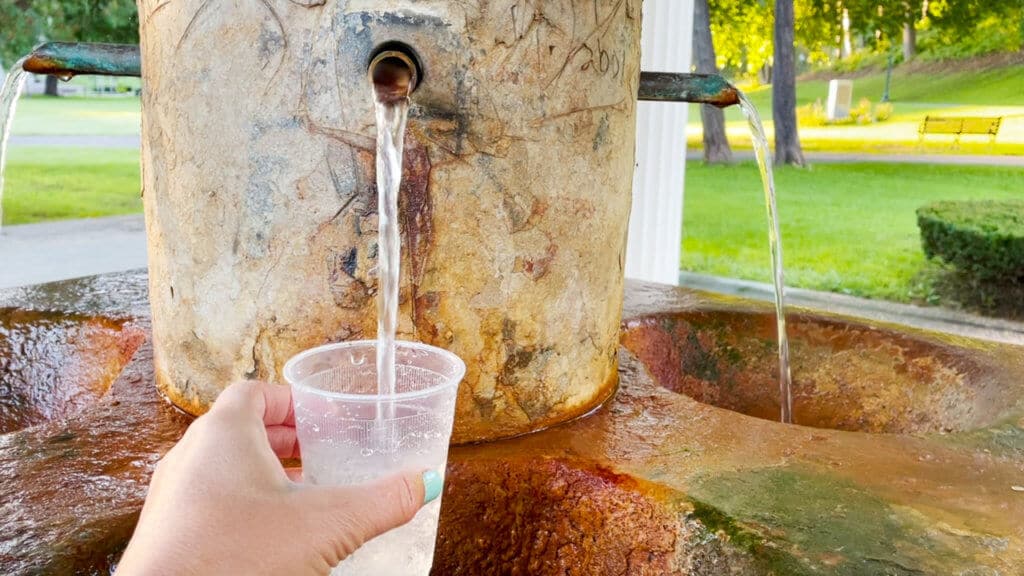
[Updated January 3, 2025] Do you believe in the restorative power of Saratoga mineral springs?
After my last trip to Saratoga Springs, NY, I’m a huge fan!
I took my first sip of mineral water from a fountain in downtown Congress Park. The water had a hint of metallic flavor and left behind a salty film on my lips. There was also a fizziness to it that took me a little by surprise.
I’m fortunate to be in good health so I didn’t set out on a healing mission. I just wanted to taste the water that flows so curiously from the Saratoga Springs water fountains and springs that are scattered around the city.
To my surprise, I experienced a burst of invigoration after sipping some of the waters. Then later in the week, I slipped into a warm mineral bath at Roosevelt Baths & Spa and felt any stress and fatigue I had built up escape my body and dissolve into thin air.
Sounds heavenly, doesn’t it?
Honestly if I lived in Saratoga Springs, the Roosevelt Baths would be on my weekly rotation of things to do. For now, though, I’ll have to savor the soothing memory. If you’re thinking of a weekend spa getaway, Saratoga Springs, located in the Capital Region of New York State, should be at the top of your list.
Read on to learn about the history of the Saratoga Springs mineral springs as well as the best places to enjoy them. And check out my video of my mineral water tasting tour! Looking for accommodations? Read about my seven recommended places to stay in Saratoga Springs.
History of Saratoga Mineral Springs and Water Fountains
Picture this geological journey.
A reservoir of water lies deep in the shale layers of earth until, powered by natural carbon dioxide gas, streams of water snake through connected underground channels. The water reaches the earth’s surface and then, thanks to a fault line, finds a crack in the earth through which it can escape.
It continues to gurgle at the surface or just below, creating a nutrient-rich continuous source of water.
Admittedly this is a super simple explanation of a complex (and kind of miraculous if you ask me) geological phenomenon.
Nevertheless, the underlying facts remain true:
- Saratoga Springs sits on a geological fault line.
- Underground streams of water mix it up with minerals and gases.
- The nutrient-dense water bubbles up to the surface.
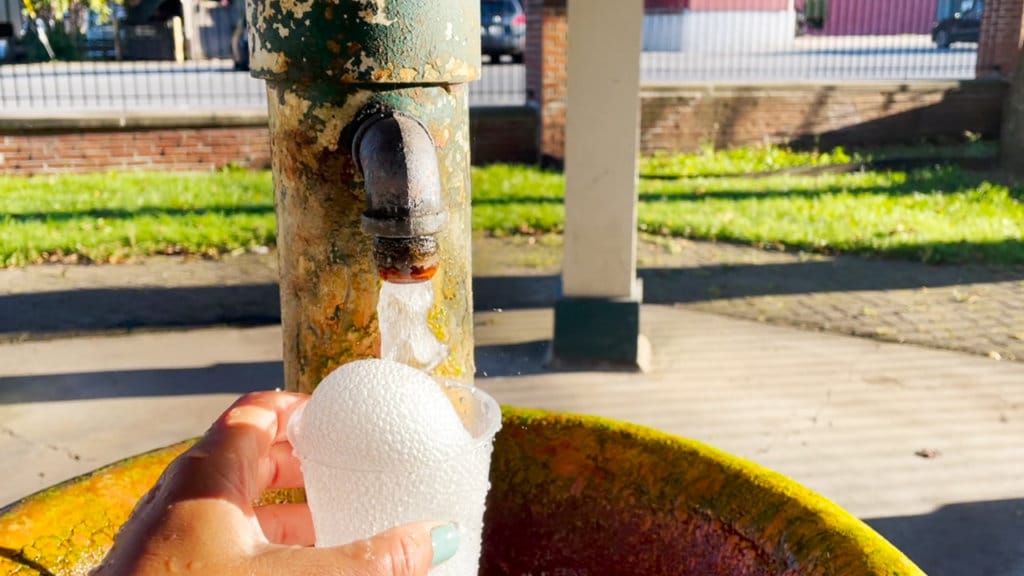
The following history is also true.
The Indigenous tribe called the Mohawks inhabited this region circa 14th century. Because the salty mineral waters lured animals, the Mohawks found Saratoga Springs to be a rich hunting ground.
They also understood that the water had curative properties. They treated it as sacred, calling it “Medicine Spring of the Great Spirit.”
And so it went for thousands of years until (shocking!) the arrival of the white settlers, namely Sir William Johnson.
Johnson immigrated to the region from Ireland in the 1740s with the purpose of overseeing an estate his uncle owned. He accomplished this task, it is believed, through the labor of enslaved individuals he bought when he arrived in the New World.
Johnson also developed a good relationship with the local Mohawk tribe. He learned their language and in 1755 was appointed by the British government as the Superintendent of Indian Affairs.
In 1771, Johnson was suffering from a bout of ill health made worse by an old war wound. His friends from the Mohawk Nation brought him to their sacred healing waters, which had a positive effect on his ailing health.
Did Johnson respect the local Indigenous community by keeping their centuries-old secret of the healing waters safe?
Nope…No, he did not.
But I’m sure you guessed that.
Word of their healing properties spread far and wide and by the 19th century, wealthy health-seeking tourists traveled in droves to the Saratoga mineral baths.
The city soon became known as “the Queen of Spas.”
Like this post? Pin it and save for future reference!
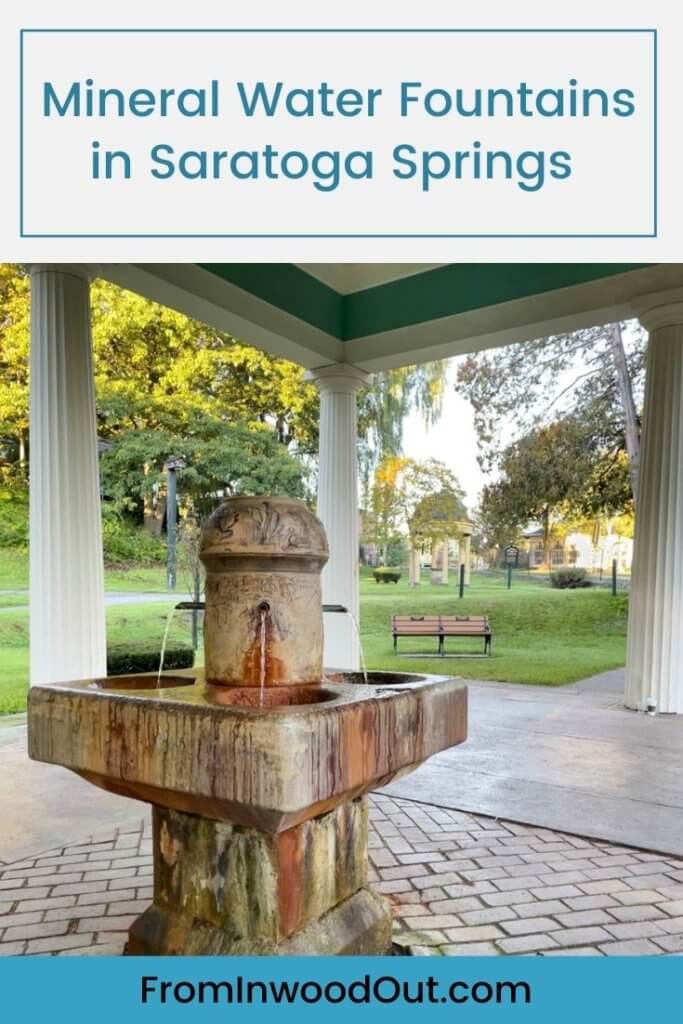
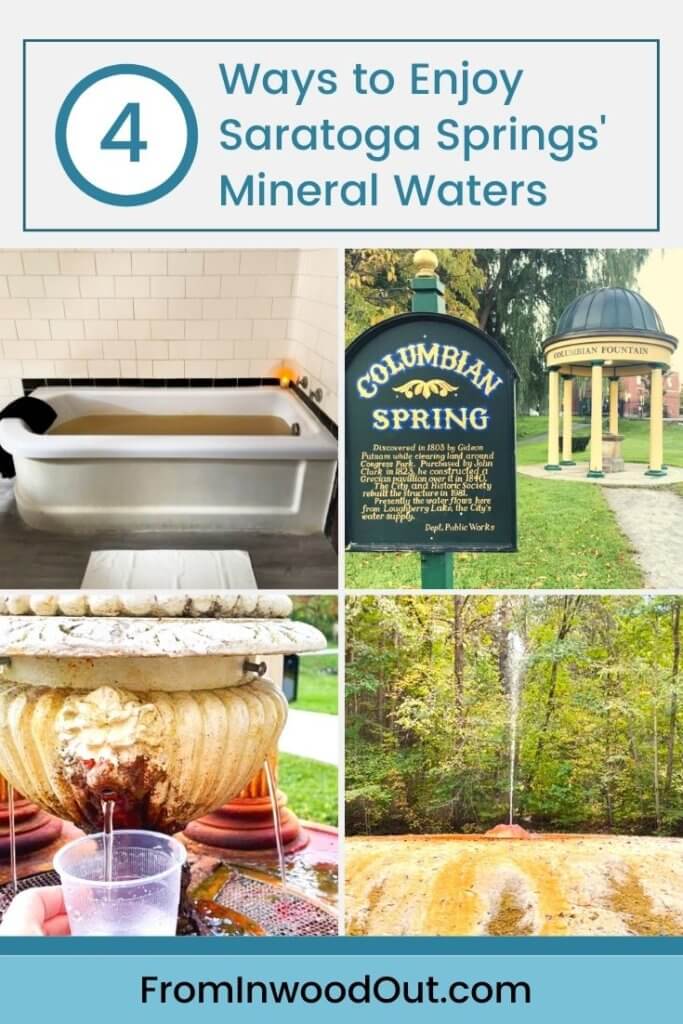
The promise of the curative waters even lured the Gilded Age’s wealthiest members with the Vanderbilts, the Whitneys, and JP Morgan arriving to soak in the city’s bath houses and sip the mineral-rich waters that flowed from the drink halls.
Health Benefits of Saratoga Springs Mineral Water
“The springs of Saratoga were the liquid vitamin pill of the Victorian era.”
That’s according to our guide during a tour of Congress Park, and I think that’s the most concise way I’ve heard it phrased.
Throughout the 19th century, ailing patients were told by their doctors to “take the waters” of Saratoga Springs. Patients flocked here to treat illness as varied as rheumatism, skin disease, gout, and cancer.

But just as different vitamins contain different nutrients, the Saratoga mineral springs varied in their advantages.
Remember, before streaming upwards to reach a crack in the earth’s surface, the water was trapped deep in the earth’s layers. The deeper its origin, the higher the concentration of minerals it contains.
The mineral water health benefits depend on the level of minerals present.
So what are these minerals? What exactly are their curative powers?
In Saratoga Springs, some mineral waters are higher in iron. That may have been a 19th century prescription to treat skin problems or shortness of breath.
Doctors may have ordered water with higher alkaline levels to treat heartburn and hangovers, while drinking mineral water high in magnesium and potassium may have been ordered to treat high blood pressure.
Author Grace Maguire Swanner, M.D. (Saratoga Queen of the Spas, 1988) broke down the springs into three curative categories:
- cathartic (laxative)
- alkaline (antacid)
- chalybeate (high in iron)
The mineral properties are really no mystery once you see or taste them. Some—like Congress Spring—flow from a fountain with built-up layers of rust; others leave a salty taste behind on the lips.
Soaking one’s body in the waters was prescribed for a multitude of problems, from arthritis to rashes to nervousness of temperament.
Personally, I booked a 40-minute soaking session and after only a minute or two in the bath, I felt a complete sense of calm, which remained for the entire duration of the bath and stayed with me for the rest of the day (more on that experience below).
One 1888 publication described “taking the cure” in this way:
The…treatment consists of mineral water, mineral baths, mastication, cheerfulness, abstemiousness, wholesome food, exercise, sleep, self-restraint, and general reasonableness of life.
From: Saratoga Chips and Carlsbad Wafers by Nathan Sheppard
Sounds like rich people just living their best life to me…
How to Find the Mineral Springs in Saratoga Springs
First, it’s important to know what you’re looking for.
Don’t be misled by the word “springs” which to me, evokes the image of a clearing in the woods with a pool of naturally steaming water to sink your aching bones into. That’s not what you’ll find here.
You CAN soak in a mineral bath at Roosevelt Baths & Spa (more on that below) but other than that, you’re looking for naturally flowing fountains in various parts of the city. In Congress Park, they resemble what public water fountains might have looked like in the Victorian Age.
In Saratoga Spa State Park, they’re spread out along a couple of different hiking trails, some shooting continual streams of water from the ground up, others sputtering out of faucets like a fussy showerhead, the ground beneath it layered with an earthy mineral build-up.
Once you know what you’re looking for, the springs are not hard to find and you may even bump into one without looking while out for a stroll, like in Congress Park.
I recommend stopping at the Saratoga Springs Visitor Center to begin your planning.
Don’t forget to take a cup or water bottle so you can sample the healing waters yourself!
How Many Natural Springs Does Saratoga Have?
There were originally 200 mineral springs. Today there only about 21 active springs remaining.
What happened to them was–in a word–industry.
It wasn’t only tourists seeking the effervescent healing waters of Saratoga Springs.
Entrepreneurs were also drawn here and by around 1880, they had figured out that one way to monetize the wells was to tap them for carbonic acid gas and use the carbonation for soda fountains.
This went on for nearly three decades until 1908 when, in an effort to protect and preserve the waters, an anti-pumping law was passed. By then it was too late for many of the springs, which had been pumped dry.
Read on to find out the 4 best ways to enjoy the Saratoga Springs Mineral Springs.
1. Take a Guided Tour of Congress Park
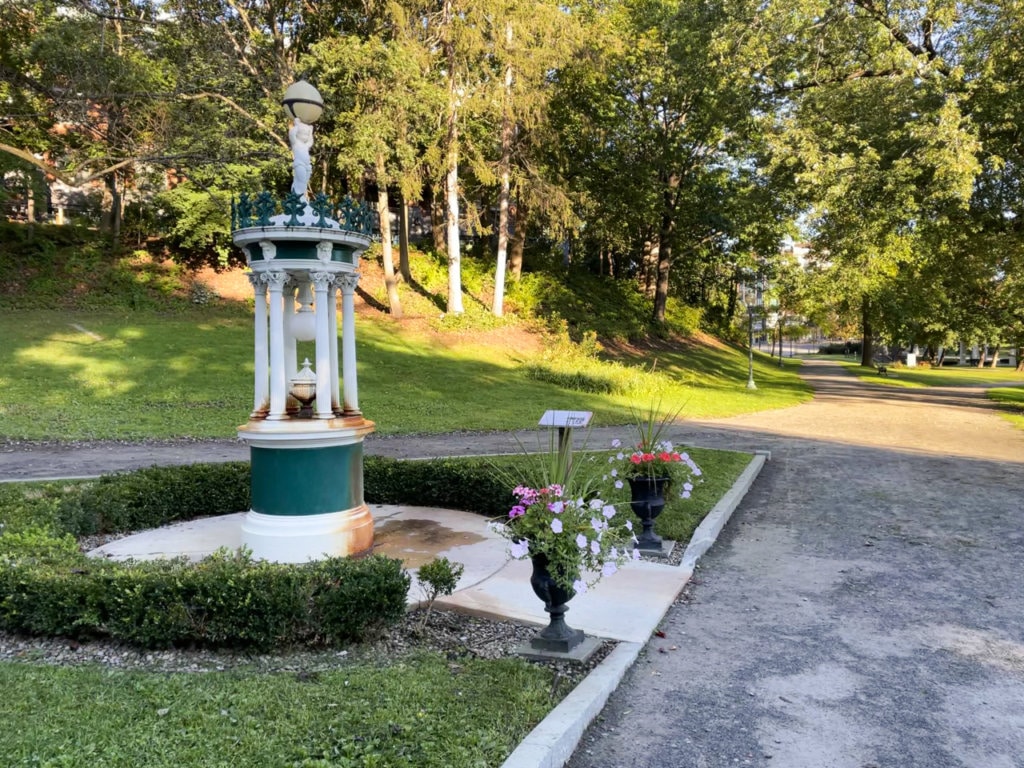
If you have the time, I highly recommend booking a tour of Congress Park. The tour isn’t solely about the mineral waters but their development as a tourist attraction are all part of the city’s history as a playground for the rich and famous.
My favorite part of the tour was stopping at each of the four mineral water fountains to sample the goods. The first sip at each fountain was especially fun because I and others on the tour had no idea how each one would taste.
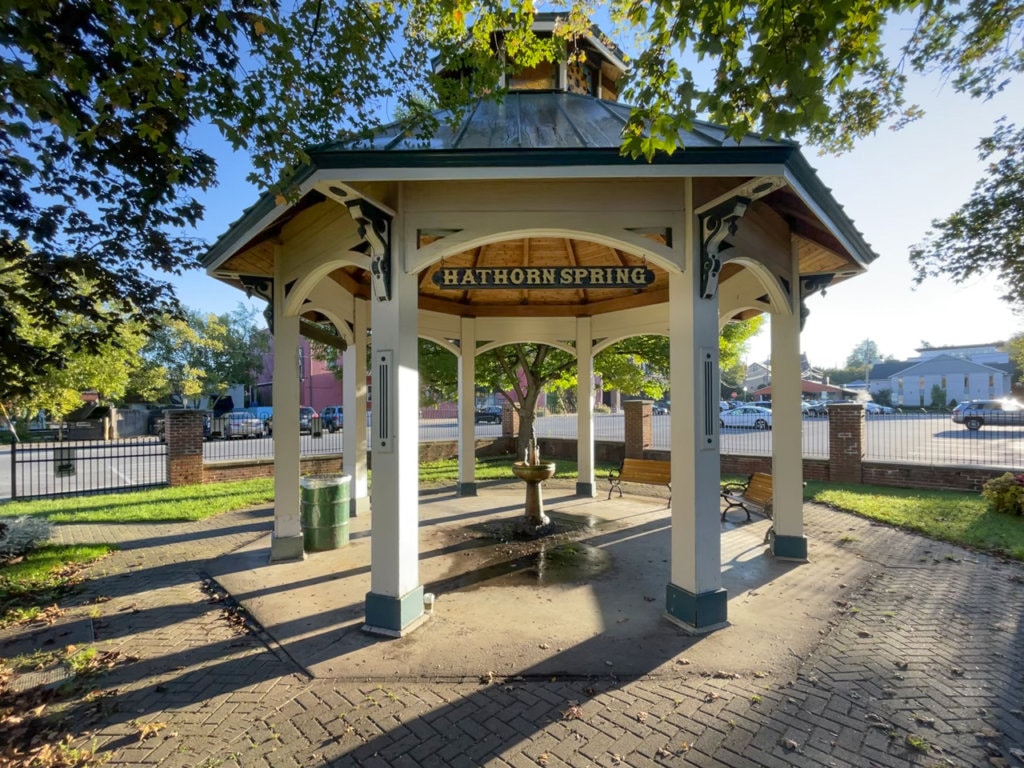
Our tour guide Marcia provided us with cups and as we tasted, she gave us the run-down on the history of the mineral waters and their purported healing properties. She talked a lot about Sir William Johnson and the role he played in making Saratoga a health-tourism destination.
Marcia is a long-time resident of Saratoga Springs and this is always one of the best parts of a tour—having access to a local to bombard with questions!
Not to worry if you don’t have time for a guided tour. Stop by the Visitor Center and pick up a brochure or download a self-guided walking tour of Congress Park map.
Mineral Water Fountains to Visit in Congress Park
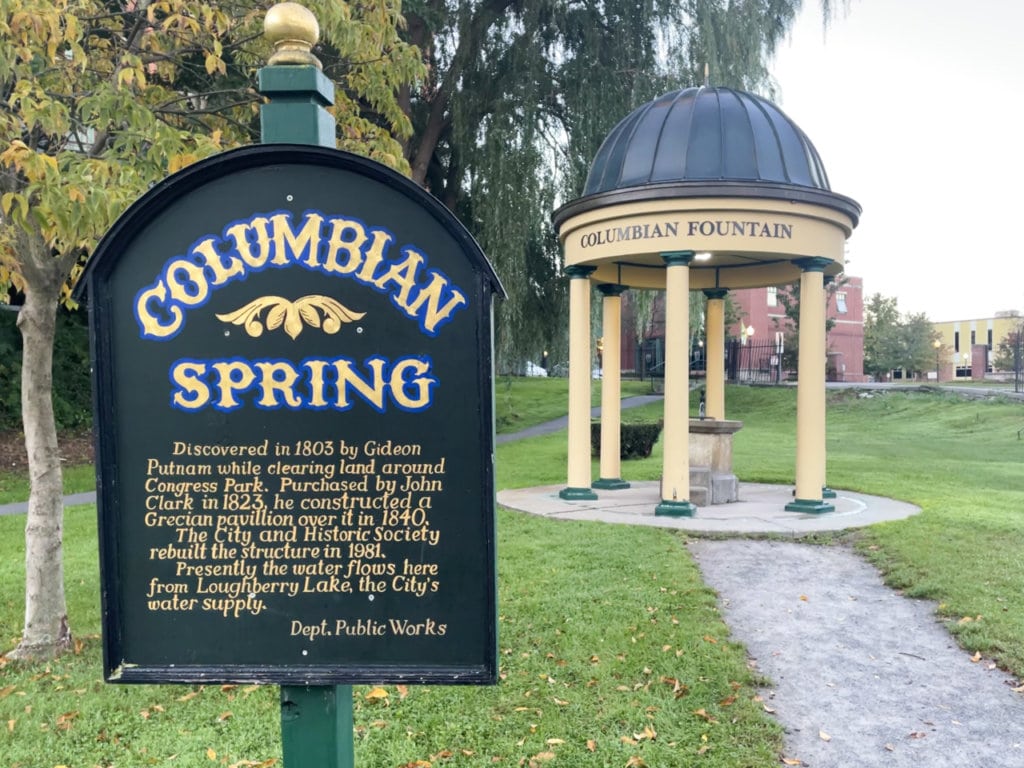
There are four mineral drinking fountains in Congress Park:
- Columbian Spring
- Congress Spring
- Deer Park Spring
- Hathorn #1 (across the street from the carousel in the park, at the corner of Putnam and Spring Streets)
They are out in plain sight and not hard to find but do get a map to make finding these Saratoga Springs water fountains easier.
If you’re heading out without a tour guide, don’t forget to bring a cup or water bottle for tasting!
2. Soak in the Roosevelt Baths
I checked in at the reception area at Roosevelt Baths & Spa 30 minutes early, as recommended when I made my online appointment. An attendant showed me to the women’s changing room, where I changed into a robe and slippers, locked up my belongings, and went to the relaxation room until I was called for my appointment.
Tea, water, and fruit were available while I waited. A spa therapist called my name right on time and took me and a few other patrons down a long hallway lined with private therapy rooms.
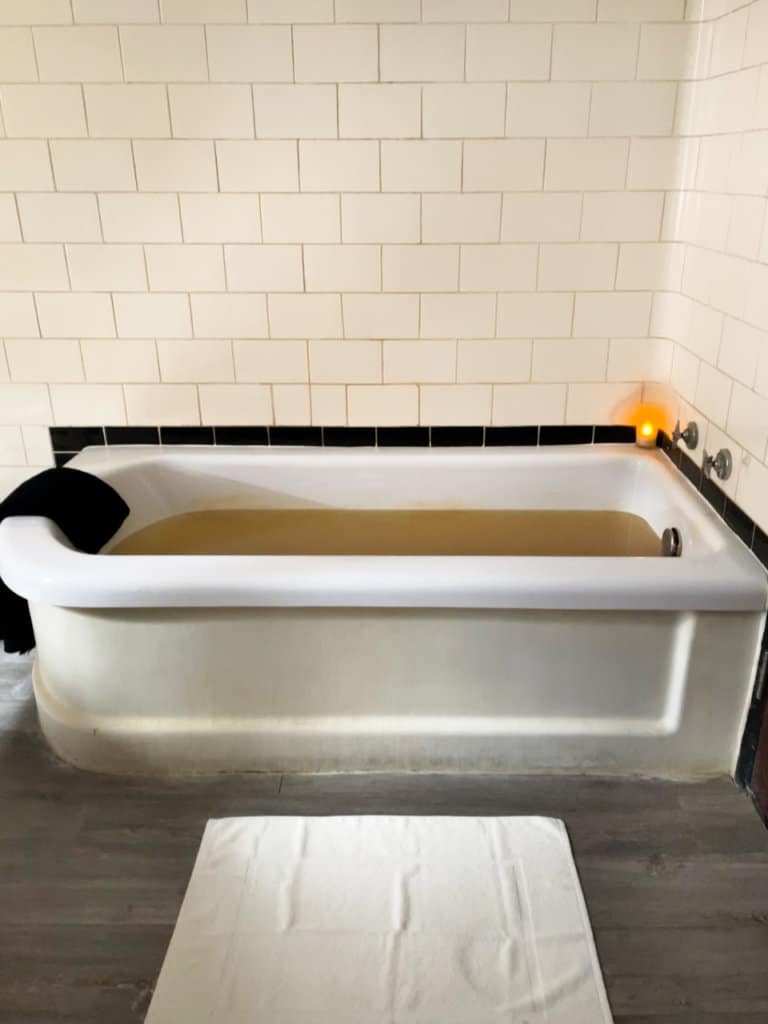
Inside my room, a mineral bath awaited. The water that fills up the deep porcelain bathtub is sourced from underground springs and because the springs in Saratoga are naturally cold, warm fresh water is added until the bath reaches body temperature.
This was an absolutely delicious and luxurious experience.
If you are in any way a spa-lover, I highly recommend this calming, stress-relieving treatment. The minerals make the water slightly buoyant while the carbonation acts like a natural bath bomb subtly tingling the skin.
The water is also a little discolored and has a slight metallic smell, but I didn’t find either of those off-putting.

I had booked a 40-minute bath and when it was done, the spa attendant opened the door a crack and hung up a heated towel for me to dry off with. I was then free to head back to the relaxation room for as long as I wanted.
The spa attendant had explained all the steps so I was totally clear on the procedure. She also told me the baths were good treatments for skin conditions, arthritis, and anxiety.
During the bath, it felt like any stress I was holding onto had physically left my body, a feeling similar to a good yoga class or the first day of a weeklong beach vacation!
I booked only a mineral bath but the spa offers a whole range of treatments, including mineral baths, massages, facials, and body scrubs.
NOTE ON TIPPING: There was a tip envelope with my spa attendant’s name on it in my private soaking room. It would have been super easy to slip a cash tip in there after my bath but I didn’t know it was going to work like that and my wallet was back in the locker room with the rest of my belongings.
Had I known, I would have had some cash ready in my bathrobe pocket to leave for her. Instead, I left the tip afterwards with reception, which was also fine but leaving the tip in the therapy room would have most convenient.
Roosevelt Baths History
After many of the mineral spring wells were tapped out for the carbonic acid gas, then-New York Governor Franklin Delano Roosevelt pushed to preserve any remaining springs.
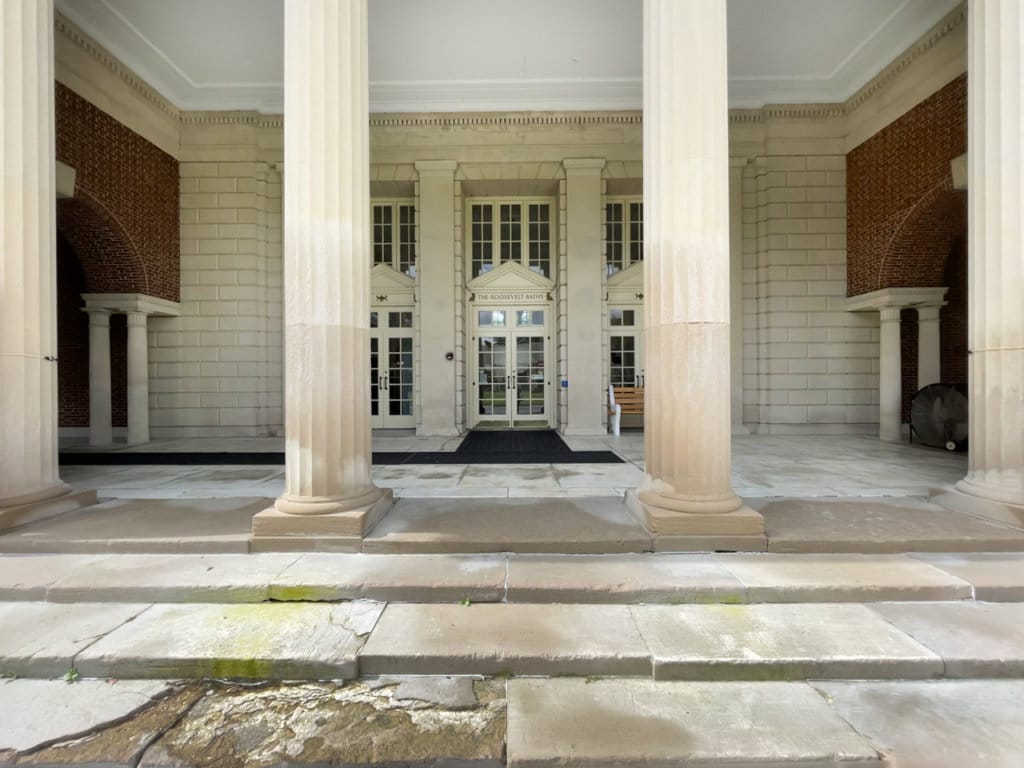
By 1935, FDR was the United States president and under his New Deal, he commissioned the building of a complex of spas, located in what is now Saratoga Spa State Park.
The buildings still exist and the grounds are a gorgeous collection of classical buildings and arcade walkways with gabled arches that were modeled after the great spas of Europe. But of the four bath houses, only Roosevelt Baths & Spa is still in operation.
Lincoln Bath closed in 2004. Washington Bath is now the National Museum of Dance, however they have not been able to reopen after their COVID shutdown. The former Bottling Plant, which bottled mineral waters and called them State Seal, is now the Saratoga Automobile Museum.
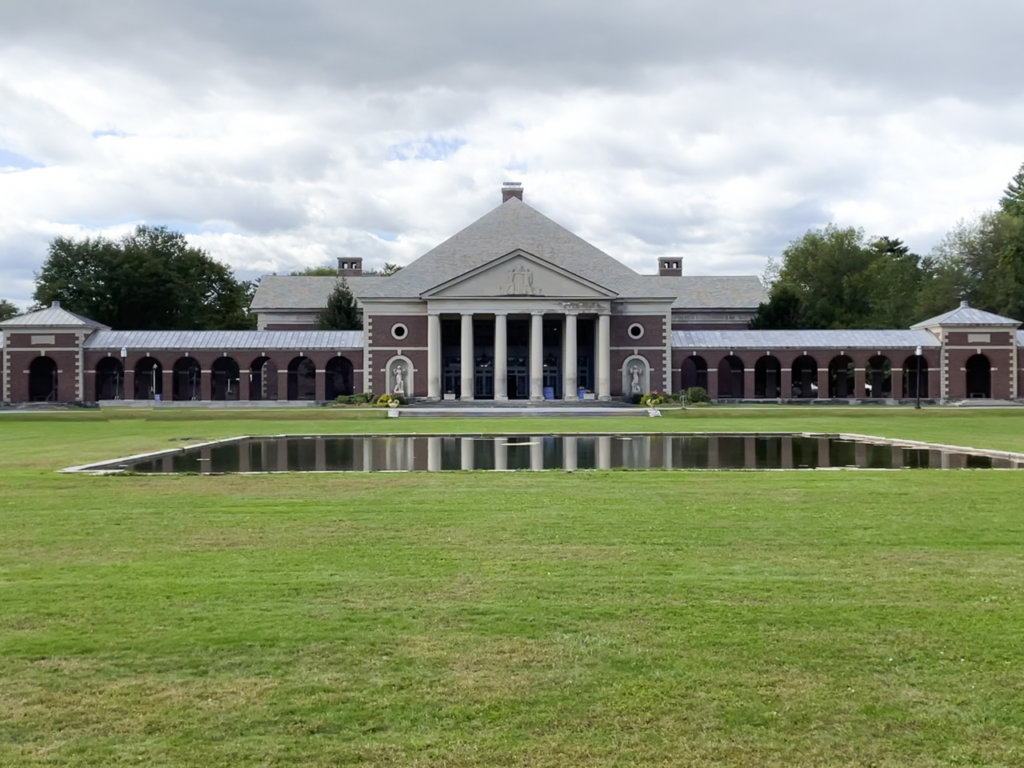
The glory days of the New Spa—as it was called then—were between the years of 1936 and 1950 with one source saying the four bath houses gave 200,000 baths in 1946, its busiest year.
While walking around the grounds of the complex after my own mineral bath, it was easy to picture patrons sitting on the terraces outside the bath houses or strolling under the arcade walkways, taking preventative cures or simply basking in the healthy environment, an oasis set apart from the stresses of everyday life.
3. Hike Saratoga Spa State Park
Love hiking? Saratoga Springs offers pleasant trails that have the added bonus of leading to natural mineral springs.

The trails at Saratoga Spa State Park are relatively short and easy. At 2.9 miles, Geyser Trail is the longest and leads hikers to the main attraction: the Geyser Island Spouter, which (though it’s no Old Faithful), is the most impressive mineral spring in town.
Water from The Geyser, as it’s known locally, spouts up from a slick multi-colored island composed of hardened mineral build-up. This one is a must-see, as is nearby Orenda Spring, which is also surrounded by an odd colorful mineral deposit.
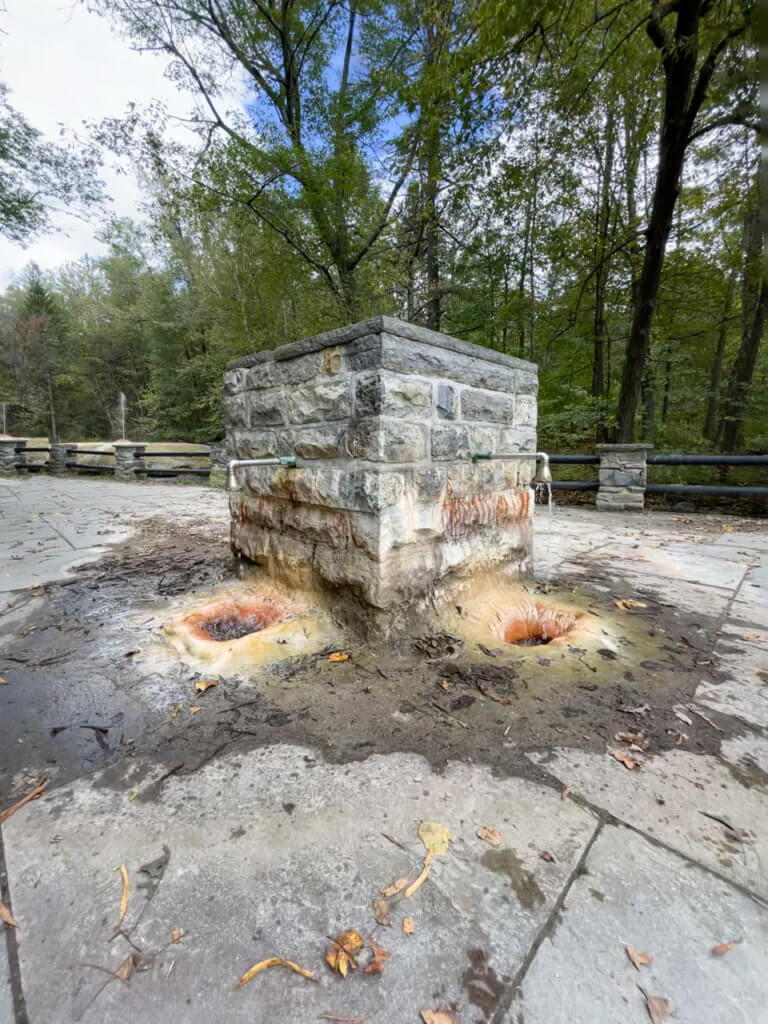
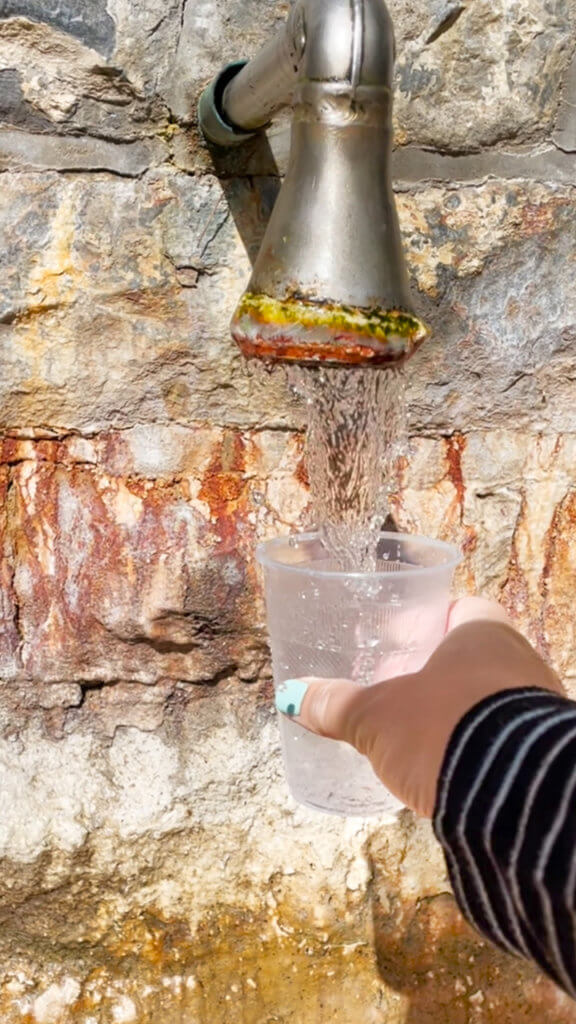
Once you reach the Geyser Island Spouter, other mineral springs are close by:
- Hayes Well Spring: Salty water in view of Island Spouter.
- Polaris Spring: Pleasant tasting. Contains low levels of radon gas.
- Tallulah: Mild tasting.
- Karista Springs: Metallic taste. Mud near the spring was historically used to treat arthritis.
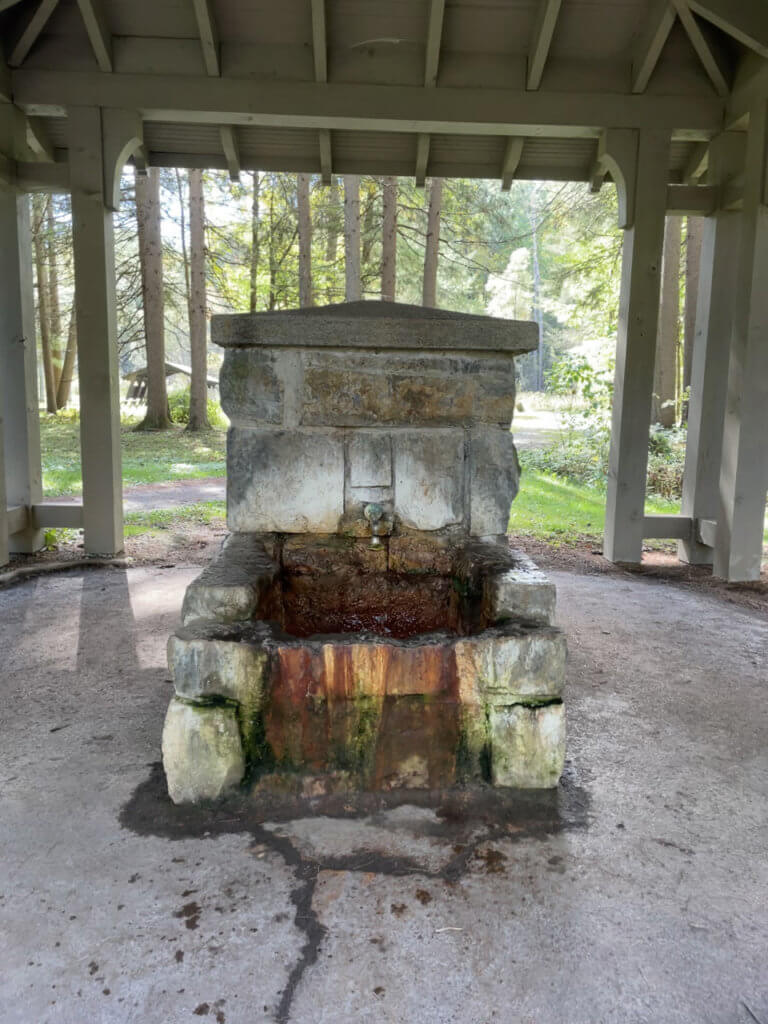
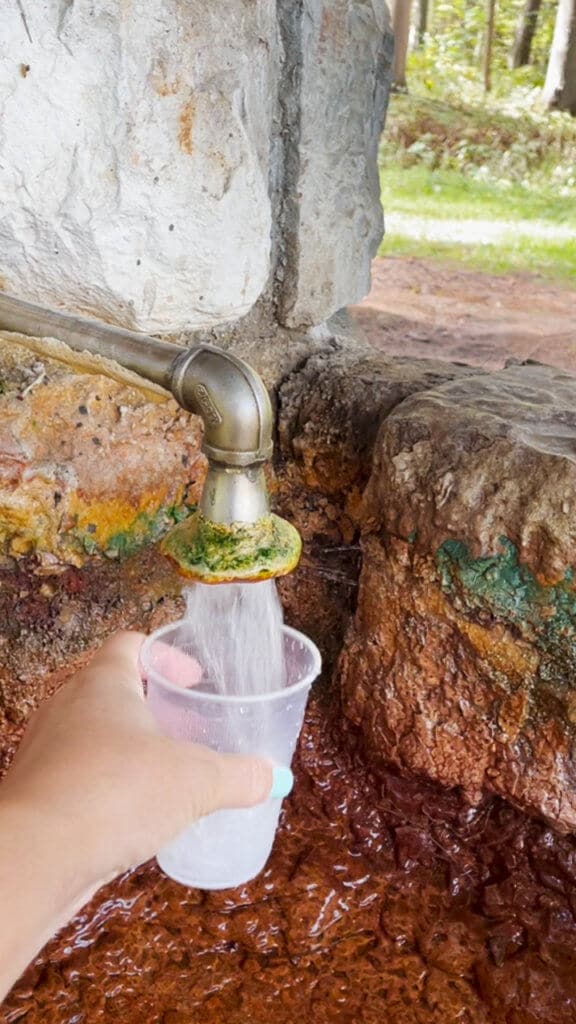
Check this trail map of Saratoga Spa State Park to find out which trails will also lead you to additional springs:
- State Seal (Springs Trail): You’re most likely to find people filling up water jugs of this fresh and delicious water.
- Charlie Spring: most recently drilled. Located near the Performing Arts Center.
- Hathorn #3: Was most popular in the heyday of the springs. Slightly cathartic, which, it will do you well to remember, that cathartic = laxative.
The park building across from Island Spouter is the Creekside Classroom. They offer occasional guided tours of the mineral springs in Saratoga Spa State Park.
If you want to devote more time to hiking in the region, read my post about hiking in Lake George. Lake George is only about 35 miles north of Saratoga Springs.
4. Visit the First Known Mineral Spring in Saratoga at High Rock Park
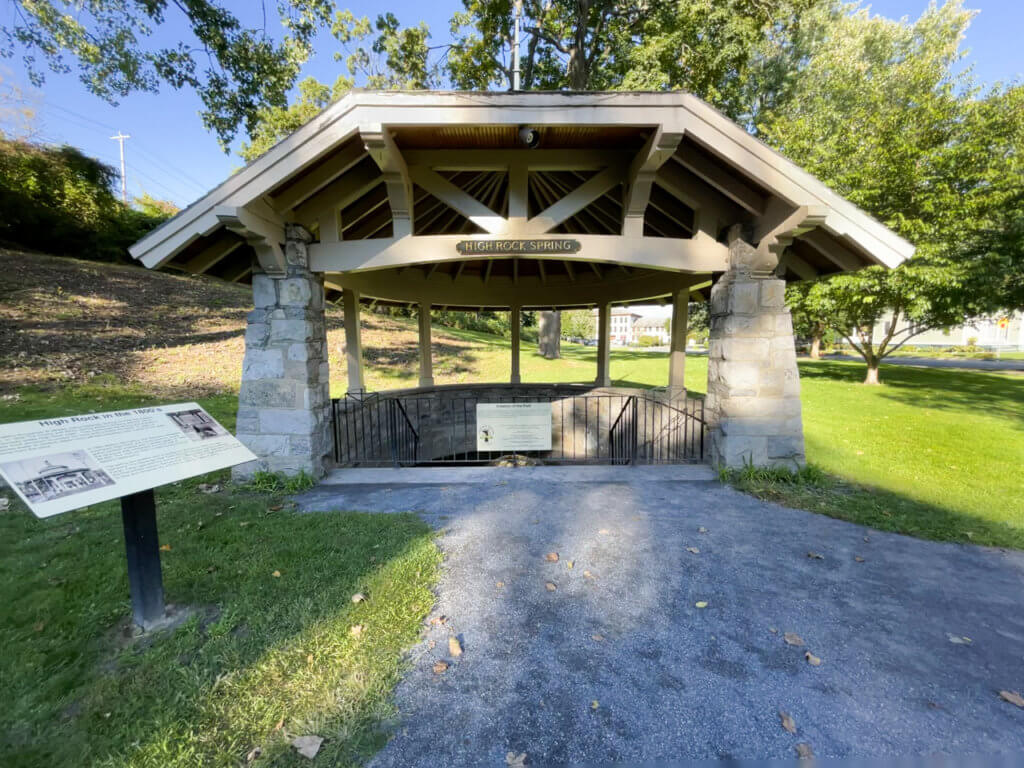
Remember Sir William Johnson, the British agent who was healed by the minerals springs, which was followed by the development of Saratoga Springs as a prime health tourism destination?
It was High Rock Springs where Johnson was taken, located in High Rock Park.
Today, High Rock Springs isn’t much to look at. It’s basically a mound of built-up minerals leaking just a tiny stream of water and is blocked from public use by a pavilion. However, because of its historical significance, it’s well worth visiting.
Soon after Johnson’s healing at High Rock, the first settlement in Saratoga Springs was established. An interesting timeline follows:
- 1848: High Rock Spring was purchased by a company who built a brick enclosure around it. They began to bottle and sell the water.
- 1865: The spring was purchased again. The new owners built a pavilion, topped with a golden eagle, around the spring.
- 1866: The pavilion was so expensive that the owners had to declare bankruptcy.
- 1872: The spring and pavilion were auctioned off. Saratoga High Rock Spring Company bought it for $16,000. They bottled and sold the water for three decades.
- 1911: High Rock Spring ran dry.
- 2015: The city redrilled High Rock Spring and it began to flow again.
One interesting thing to note: when the first protective enclosure was built around the springs in 1848, young attendants called “dipper boys” provided visitors with samples of the water. One of the “dippers” they used can be seen at the Saratoga Springs History Museum.
If you climb the stairs in the park, you’ll see that an artifact from the earliest settlement still exists in the form of the popular Olde Bryan Inn, a restaurant still in operation that was first established in 1773.
Additional mineral spring water fountains in the High Rock Area include Governor Spring, Peerless Spring, Empire Spring, and Old Red Spring.
Tips for Visiting Saratoga Mineral Springs
- Stop at the Saratoga Springs Visitor Center and grab all the brochures you can find related to the mineral springs.
- Talk to the knowledgeable staff who work there.
- Take a guided tour, either at Congress Park or Saratoga Spa State Park.
- If visiting without a tour, take a water bottle or paper cup to sample the waters.
How to Get to Saratoga Springs
Saratoga Springs is located in the Capital Region of New York state, just off Route 87N. Approximate driving distance and time from major cities:
- Albany: 40 miles. 45-minute drive.
- New York City: 185 miles. 3-hour drive.
- Syracuse: 140 miles. 2.5-hour drive.
- Montreal: 200 miles. 3.5-hour drive.
Greyhound and Trailway buses and Amtrak trains all stop at Saratoga Springs. The closest international airport is in Albany (ALB).
Like this post? Pin it and save for future reference!


Answering Your FAQs About Saratoga Springs Mineral Springs
Can you drink Saratoga Springs water?
Absolutely. Any mineral springs water with public access is fine to drink. Visitors will also find bottled water from the Saratoga Spring Water company in local hotels, restaurants, and shops.
What does the mineral water in Saratoga Springs taste like?
It depends on the source of the water. Some have a salty taste, others are rusty like iron. Some are neutral and leave little impression. I tasted the water at Hathorn #1 (near Congress Park) and it was almost exactly like sipping on AlkaSeltzer.
The water remains at a constant 55 degrees Fahrenheit year-round, in contrast to hot springs that dot the Western states in the U.S.
One article I read said the mineral waters taste different depending on the time of year, and my Congress Park tour guide Marcia said they gush more strongly during a full moon.
Are the mineral fountains free to visit?
Yes. The only experience I’ve talked about that costs money is a bath at Roosevelt Baths & Spa. The others are free mineral springs and are scattered around the city.
What minerals are in Saratoga Springs Water?
The waters all essentially contain the same minerals but the levels vary depending on how deep in the earth the water came from.
Some examples of minerals that can be found in the waters are sodium, calcium, magnesium, ammonia, iron, and chloride.
Several different pamphlets that I collected list the level of minerals that can be found in each spring, like in this Mineral Springs Guide to Saratoga Spa State Park.
Is the mineral water carbonated?
Yes, though the level of fizziness varies. The natural carbonation, caused by the carbonic acid interacting with the water, is one of the fascinating properties that makes the mineral water springs in Saratoga unique.
Why does it smell like eggs?
That smell comes from the sulfur gas which, because it’s a gas, exists in the air rather than in the water. So even if you do smell eggs—which I rarely did and only slightly—you shouldn’t taste it in the water.
I loved running around town and checking out the Saratoga mineral springs in all its different forms. And even though I didn’t—luckily—have an affliction to heal, I did end up benefitting from the stress-reducing properties the waters are supposed to have.
Have you experienced the mineral waters in Saratoga? Let me know what your favorite part of the experience was!